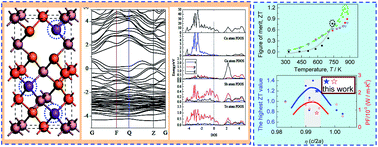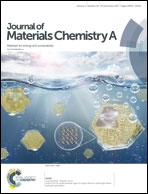Significant improvement in the thermoelectric performance of Sb-incorporated chalcopyrite compounds Cu18Ga25SbxTe50−x (x = 0–3.125) through the coordination of energy band and crystal structures†
Abstract
A newly developed chalcopyrite semiconductor Cu18Ga25Te50 (Cu/Ga = 0.72) has an inherent deficiency in Cu. Therefore, it is taken as a thermoelectric candidate due to a high vacancy rate of copper. In this work, we have observed that after Sb substitution for Te in Cu18Ga25SbxTe50−x, the active Sb-5p orbital hybridizes with those of Cu-4s and Te-5p in the valence band, which makes the Fermi level (Ef) unpin and move toward the inner side of the valence band as Sb content increases. The alteration in the band structure, which is the determining factor, causes the Hall carrier concentration (nH) to rise by more than one order of magnitude compared with those in pristine Cu18Ga25Te50, thereby significantly increasing the power factor (PF). Combined with the relatively low thermal conductivity, caused by the increased lattice disorder and general diminution of the crystal structure distortion as the x value increases, we have attained the best TE performance, where ZT reaches the highest value of 1.2 for the Sb-incorporated Cu18Ga25SbxTe50−x (x = 2.5) at 854 K. This result suggests that the coordination of energy band and crystal structures is a good approach to achieving high TE performance via the appropriate distortion of the crystal structure of ternary chalcopyrite semiconductors.



 Please wait while we load your content...
Please wait while we load your content...